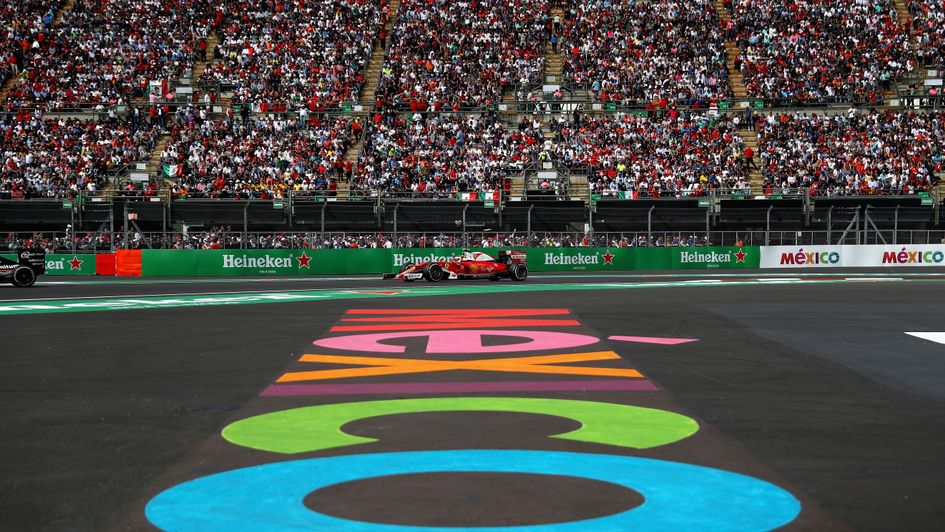All the key details ahead of the Mexican Grand Prix, including the full weekend race schedule, start times and TV coverage, a track guide and latest odds.
Mexican Grand Prix: Weekend schedule & TV guide
Friday October 25
- Practice 1: 1600 BST
- Practice 2: 2000 BST
Saturday October 26
- Practice 3: 1600 BST
- Qualifying: 1900 BST
Sunday October 27
- Race: 1810 GMT
TV coverage
Sky Sports F1 will be broadcasting the race and all the other sessions live.
Mexican Grand Prix: Sky Bet odds
Max Verstappen is 100/30 to make it a hat-trick of wins in Mexico, as Charles Leclerc and Lewis Hamilton top the market.
F1 Insider tips
Mexican Grand Prix: Track guide
- Venue: Autódromo Hermanos Rodríguez
- Circuit length: 4.304 km (2.674 mi)
- Race distance: 305.354 km (191.117 mi)
- Laps: 71
- Turns: 17
- 2018 winner: Max Verstappen (Red Bull)
- 2018 pole position: Daniel Ricciardo (Red Bull)
- 2018 fastest race lap: Valtteri Bottas (Mercedes)
How can Hamilton win the title?
- He wins, records the fastest lap and Bottas finishes fourth or lower.
- He is second, records the fastest lap and Bottas is eighth or lower.
- He is third, records the fastest lap and Bottas is 10th or lower.
- He wins without recording the fastest lap and Bottas is fifth or lower.
- He is second without recording the fastest lap and Bottas is eighth or lower.
- He is third without setting the fastest lap and Bottas is 10th or lower.
But if Bottas records the fastest lap this is how Hamilton would win the title...
- He wins and Bottas is fifth or lower.
- He is second and Bottas is ninth or lower.
- He is third and Bottas is outside the top 10.
Mexican Grand Prix: Last five podiums
2018
- Max Verstappen (Red Bull)
- Sebastian Vettel (Ferrari)
- Kimi Raikkonen (Ferrari)
2017
- Max Verstappen (Red Bull)
- Valtteri Bottas (Mercedes)
- Kimi Raikkonen (Ferrari)
2016
- Lewis Hamilton (Mercedes)
- Nico Rosberg (Mercedes)
- Daniel Ricciardo (Red Bull)
2015
- Nico Rosberg (Mercedes)
- Lewis Hamilton (Mercedes)
- Valtteri Bottas (Williams)
2014
- No race
Fact file
- At 4.304km, the Autódromo Hermanos Rodríguez is the second shortest circuit on the F1 calendar after the Circuit de Monaco.
- The Mexican Grand Prix is one of three races in the season that has 71 laps, together with Brazil and Austria.
- The 811-metre run from pole position to the first braking zone is the second longest in F1, only behind Russia. 9.6 seconds of it are completed at full throttle.
- The Autódromo Hermanos Rodríguez has the highest altitude on the calendar, situated 2,285m above sea level. Before Mexico returned to the F1 calendar, the track with the highest altitude was Interlagos in Brazil, 800m above sea level.
- Despite the high altitude, the Autódromo Hermanos Rodríguez is one of the flattest tracks on the calendar, with the third smallest elevation change - 2.8m over the 4.304km lap. Only Melbourne and Sochi, both of which are only slightly above sea level, have less elevation change.
- The high altitude means that the ambient pressure is the lowest of the season by far, around 780mb. Oxygen levels at this altitude are 78% of what they are at sea level and this reduction in air density has an impact on the Formula One cars.
- The Power Unit is the most affected by the low atmospheric pressure. A normally-aspirated engine would suffer a significant drop in power (around 20%). A turbocharged engine can make up for this but the turbo has to work much harder than in normal conditions to achieve it, which increases temperatures.
- The thin air also means that it is less effective to cool the car, so the Power Unit and brakes run hotter. Bodywork with increased cooling is required to address this.
- The thin air and increased cooling have two consequences on the aerodynamics of the car: less downforce and less drag. We run a rear wing equivalent to Monaco, but despite this, the actual downforce on the car is closer to the levels experienced in Monza.
- Because of these factors, Mexico sees some of the highest straight-line speeds of the season with cars reaching 370km/h in a tow.
- Some of the highest track temperatures of the year are experienced in Mexico, with an average temperature of 43.5°C and maximum temperatures of up to 52°C in previous years. This is in part due to the very dark tarmac.
- There is a third DRS zone for the 2019 Mexican Grand Prix, running between Turn 11 and Turn 12, with a detection point at Turn 10.
- Despite the long main straight, the track has statistically the third fewest overtakes over the years.
- The fastest corner on the circuit is Turn 9, taken at around 250 km/h. Drivers experience 4.1G through this corner, the most of any on the track. The slowest corner is Turn 13, taken at under 70km/h. This is one of the slowest turns of the entire season










